Spectacular Puruogangri Glacier faces global warming problem
People's Daily app
1578552456000

The Puruogangri Glacier is located in the core area of the Qiangtang National Nature Reserve, spanning 420 square kilometers, with a maximum altitude of 6,200 meters. It is the largest glacier on the planet except the Antarctic and Arctic. (Photos: People's Daily/ Deng Jiansheng)

The Puruogangri Glacier is surrounded by volcanic craters with a lake below. Frequent volcanic activity produces abundant geothermal resources so that there are luxuriant plants living around the lake. For thousands of years, tens of thousands of Tibetan antelopes have been there for winter, according to He Rizheng, a PhD supervisor at the Chinese Academy of Geological Sciences.

Even the huge Puruogangri Glacier cannot escape the effects of global warming. Yao Tandong, one of the earliest scientists who entered the Puruogangri Glacier to conduct scientific research, found that the Puruogangri ice sheet had already retreated in 2000 and the speed was increasing.

In the past 50 years, the cryosphere of the Qinghai-Tibet Plateau has melted rapidly, reduced from 53,000 square kilometers to 45,000 square kilometers. Melting glaciers have increased surface runoff. Scientific investigation found that the number of lakes larger than one square kilometer on the Tibetan Plateau increased from 1,081 to 1,236, and the area of lakes increased from 40,000 square kilometers to 47,400 square kilometers.(Compiled by Huang Dongpeng)


